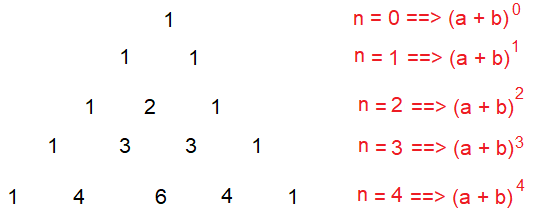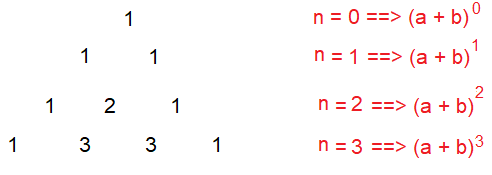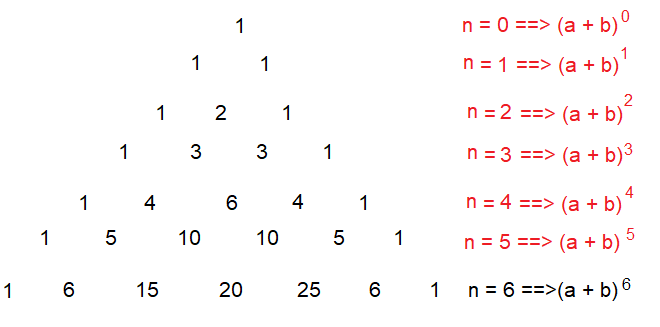USING PASCAL TRIANGLE TO EXPAND BINOMIALS
Consider the following expanded powers of (a + b)n, where a + b is any binomial and n is a whole number. Look for patterns.

Each expansion is a polynomial. There are some patterns to be noted.
1. There is one more term than the power of the exponent, n. That is, there are terms in the expansion of (a + b)n.
2. In each term, the sum of the exponents is n, the power to which the binomial is raised.
3. The exponents of a start with n, the power of the binomial, and decrease to 0. The last term has no factor of a. The first term has no factor of b, so powers of b start with 0 and increase to n.
4. The coefficients start at 1 and increase through certain values about "half"-way and then decrease through these same values back to 1.
Use the binomial expansion of (a + b)³ to expand and simplify:
Problem 1 :
(x + 1)³
Solution :

From the pascal triangle above,
(a + b)³ = a³ + 3a²b + 3ab² + b³
a = x and b = 1
(x + 1)³ = x³ + 3(x)²(1) + 3(x)(1)² + 1³
(x + 1)³ = x³ + 3x² + 3x + 1
Use (a + b)4 = a4 + 4a3b + 6a2b2 + 4ab3 + b4 to expand and simplify:
Problem 2 :
(x - 2)4
Solution :
Using pascal's triangle, we get

Since, we have negative in the middle, we
(a - b)4 = a4 - 4a3b + 6a2b2 - 4ab3 + b4
a = x and b = 2
(x - 2)4 = x4 - 4(x)3(2) + 6(x)2(2)2 - 4(x)(2)3 + (2)4
(x - 2)4 = x4 - 8x³ + 24x² - 32x + 16
Problem 3 :
(2x + 3)4
Solution :
(a + b)4 = a4 + 4a3b + 6a2b2 + 4ab3 + b4
a = 2x and b = 3
(2x + 3)4 = (2x)4 + 4(2x)3(3) + 6(2x)2(3)2 + 4(2x)(3)3 + (3)4
(2x + 3)4 = 16x4 + 96x³ + 216x² + 216x + 81
Problem 4 :
(x + 1/x)4
Solution :
(a + b)4 = a4 + 4a3b + 6a2b2 + 4ab3 + b4
a = x and b = 1/x
(x + 1/x)4 = (x)4 + 4(x)3(1/x) + 6(x)2(1/x)2 + 4(x)(1/x)3 + (1/x)4
(x + 1/x)4 = x4 + 4x² + 6 + 4/x² + 1/x4
Problem 5 :
(2x - 1/x)4
Solution :
(a - b)4 = a4 - 4a3b + 6a2b2 - 4ab3 + b4
a = 2x and b = 1/x
(2x - 1/x)4 = (2x)4 - 4(2x)3(1/x) + 6(2x)2(1/x)2 - 4(2x)(1/x)3 + (1/x)4
(2x - 1/x)4 = 16x4 - 32x² + 24 - 8/x² + 1/x4
Problem 6 :
Expand (2 + x)6
(2 + x)6
Solution :

(a + b)6 = a6 + 6a5b + 15a4b2 + 20a3b3 + 15a2b4 + 6ab5 + b6
a = 2 and b = x
Substitute 2 for a and x for b.
(2 + x)6 = (2)6 + 6(2)5(x) + 15(2)4(x)2 + 20(2)3(x)3 + 15(2)2(x)4 + 6(2)(x)5 + x6
(2 + x)6 = 64 + 192x + 240x2 + 160x3 + 60x4 + 12x5 + x6
Problem 7 :
Use the expansion of a to find the value of (2.01)6.
Solution :
a = 2.01 and b = 0
Substitute 2.01 for a and 0 for b.
(2.01 + 0)6 = (2.01)6 + 6(2.01)5(0) + 15(2.01)4(0)2 + 20(2.01)3(0)3 + 15(2.01)2(0)4 + 6(2.01)(0)5 + (0)6
(2.01 + 0)6 = 65.944
So, the value of (2.01)6 is
65.944
Problem 8 :
Expand and simplify (2x + 3) (x + 1)4.
Solution :
(a + b)4 = a4 + 4a3b + 6a2b2 + 4ab3 + b4
= (2x + 3) (x + 1)4
= (2x + 3) (x4 + 4x3 + 6x2 + 4x + 1)
= 2x(x4 + 4x3 + 6x2 + 4x + 1) + 3(x4 + 4x3 + 6x2 + 4x + 1)
= 2x5 + 8x4 + 12x3 + 8x2 + 2x + 3x4 + 12x3 + 18x2 + 12x + 3
= 2x5 + 11x4 + 24x3 + 26x2 + 14x + 3
Problem 9 :
Find the coefficient of:
a³b² in the expansion of (3a + b)5
Solution :
Using pascal's triangle,
(a + b)5 = a5 + 5a4b + 10a3b2 + 10a2b3 + 5ab4 + b5
(3a + b)5 = (3a)5 + 5(3a)4b + 10(3a)3b2 + 10(3a)2b3 + 5(3a)b4 + b5
(3a + b)5 = 243a5 + 135a4b + 270a3b2 + 90a2b3 + 15ab4 + b5
So, coefficient of a3b2 is 270.
Problem 10 :
a³b3 in the expansion of (2a + 3b)6.
Solution :
(a + b)6 = a6 + 6a5b + 15a4b2 + 20a3b3 + 15a2b4 + 6ab5 + b6
(2a + 3b)6 = (2a)6 + 6(2a)5(3b) + 15(2a)4(3b)2 + 20(2a)3(3b)3 + 15(2a)2(3b)4 + 6(2a)(3b)5 + (3b)6
(2a + 3b)6 = 64a6 + 576a5b + 2160a4b2 + 4320a3b3 + 4860a2b4 + 2916ab5 + 729b6
So, coefficient of a3b3 is 4320.
Recent Articles
-
Finding Range of Values Inequality Problems
May 21, 24 08:51 PM
Finding Range of Values Inequality Problems -
Solving Two Step Inequality Word Problems
May 21, 24 08:51 AM
Solving Two Step Inequality Word Problems -
Exponential Function Context and Data Modeling
May 20, 24 10:45 PM
Exponential Function Context and Data Modeling